Famous cats in history
The Princeton Cat Experiment
In 1929, two Princeton researchers, Professor Ernest Wever and his research assistant Charles Bray turned a live cat into a working telephone by removing part of its skull and most of its brain to attach a telephone wire between the cat’s right auditory nerve and a telephone receiver.
Bray would speak into the cat’s ears while Wever listened through the receiver 50 feet away in a soundproof room. This experiment proved that the frequency of the response in the auditory nerve is correlated to the frequency of the sound.
From their findings through these experiments, Wever and Bray were awarded the first Howard Crosby Warren Medal of Society by the Society of Experimental Psychologists in 1936.
Wever and Bray’s later research later laid the foundation for cochlear implants, which help deaf people hear by stimulating their auditory nerve.
Cats in Trenches
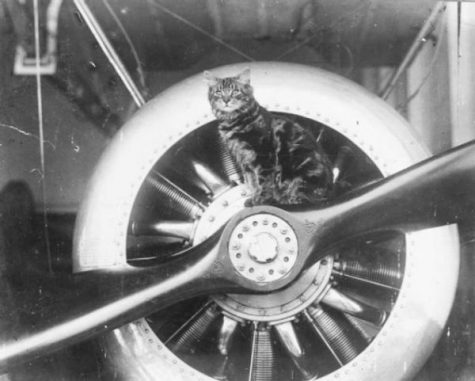
Photographer not identified, taken circa 1916, Some rights reserved, license link: https://www.flickr.com/commons/usage/,
Original link of work: https://www.awm.gov.au/collection/304910
Cats were deployed into the battleships and the trenches during both World Wars to hunt mice and rats. In the trenches, they were also employed as gas detectors.
Most importantly, cats served as a morale boost for soldiers, and many were adopted as mascots by the servicemen.
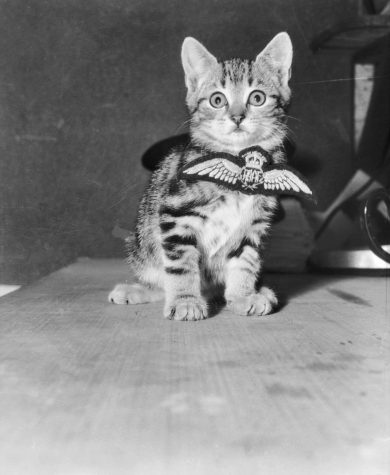
Photo by Herald Newspaper , taken March 24, 1943, Some rights reserved, license link: https://www.flickr.com/commons/usage/,
Original link of work: https://www.awm.gov.au/collection/138288/
Room 8
In 1952, the gray stray cat wandered into a classroom at Elysian Heights Elementary School in Los Angeles. After his constant returns, the students named him “Room 8”, after the number of their room. He was loved and cared for by the students and teachers, eventually becoming the school mascot. Room 8 grew more and more famous, as local and eventually national news media took notice of him.
In 1964, Room 8’s pawprints were imbedded in wet cement in the front of the school. These pawprints and their inscription, “Room 8 – School Cat” remain to this day.
Room 8 never missed a day of school until his death in 1968, at the estimated age of 22. He is buried in the LA Pet Memorial Park in Calabasas, California.
Room 8 now has a memorial cat foundation in his honor.
Félicette, the First Cat in Space
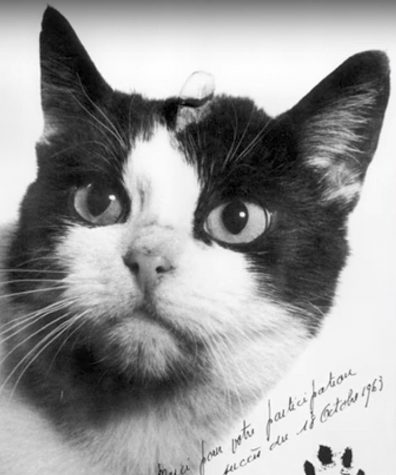
Photo by Deefaze, published Nov. 16, 2017, Some rights reserved, license link: https://creativecommons.org/licenses/by-sa/4.0/deed.en,
Original link of work: https://upload.wikimedia.org/wikipedia/commons/0/0d/Felicette-chat-18-octobre-1963-france-veronique2.jpg
On October 18,1963, a French cat named Félicette became the first and only cat to visit space, launched atop a Véronique AG1 rocket from a base in Hammaguir, Algeria. Her flight researched a height of 157 kilometers (nearly 100 miles) and included 5 minutes of weightlessness, before her capsule was parachuted back down to earth and was met by a helicopter recovery 15 minutes after launch.
14 cats were put into training for this space flight mission. Ultimately, Félicette was chosen, either due to her calm demeanor or because the other cats had put on too much weight.
Félicette’s flight brought the French space program, the world’s third civilian space agency after the U.S. and the Soviet Union, into the space race. This flight and others around the world were designed to observe how lack of gravity could affect animals.
Unfortunately, while other animals launched into space are well known, many have never heard of Félicette. Those who have heard of the only cat launched into space often mistakenly know her as Félix, since a series of commemorative stamps somehow all assumed that she was a male cat.
A kickstarter in 2017 successfully raised £43,323 to build a monument in Félicette’s honor in her hometown, Paris.
Koko’s cat
Koko, the gorilla who gained worldwide fame after she learned American Sign Language, was also a cat lover. Her favorite picture books included “The Three Little Kittens” and “Puss ‘n’ Boots.” In 1984, Koko asked researchers for a kitten as a Christmas present.
When researchers first tried to appease her with a realistic stuffed animal, she grew upset, tossing it aside and repeatedly signing “sad.”
On her birthday in July, she was finally allowed her to choose a kitten from among several in a litter. Koko adopted a male Manx, who she named “All Ball” as a joke.
All Ball had been rejected by his mother when he was four weeks old and was mothered by a terrier until he was adopted. Koko treated All Ball like her own child. As Ron Cohn, a biologist with the Gorilla Foundation running Koko’s research project, described:
“They would play chase with each other and she (Koko) would hold it and pet it,” Cohn said. “The cat reacted to her as she would a human, but she was pretty independent and would bite Koko or wriggle loose when she got tired of being babied.”
In mid-December, All Ball escaped the cage and was run over by a car. When researchers told Koko the news, she pretended to not hear them for then minutes, before whimpering, a sound gorillas make when they are sad, and signing “Sleep. Cat.”
Mayor Stubbs
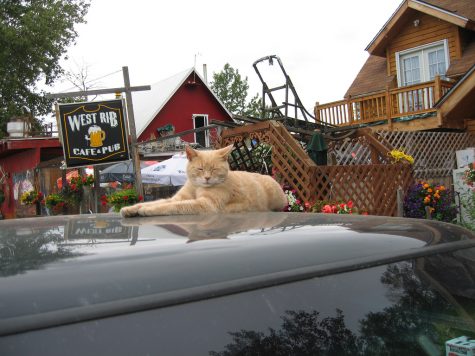
Original link of work: https://www.flickr.com/photos/queen_of_subtle/186866983/in/photolist-hvK3x-ffH74z-ffFXna-czASrA-aCVu3d-ffWM43-uEV3Ji-uEU1Qk-Ugjv2Z-KSfCDx-czASNs
In 1998, due to the absence of any adequate human candidates, the small town of Talkeetna, Alaska, elected the yellow kitten Stubbs in a write-in campaign. Stubbs was an incredibly popular mayor, receiving good press and boosting the town’s tourism, becoming renowned for drinking water and catnip from a margarita glass, as well as his friendly, almost puppy-like personality. After his death at the age of 20 in 2017, Stubbs was succeeded by Denali, a cat with the same personality as him.
Oscar, the feline Grim Reaper
Oscar made national headlines during the last decade due to his uncanny ability to predict death. The staff at the Steere House Nursing and Rehabilitation Center in Rhode Island adopted him in 2005 as a therapy cat. However, Oscar was hostile to patients, except for those on the verge of death.
Everyone he napped with would pass away within a few hours. He never made an incorrect prediction, to the point that doctors and nurses would urge family members to come and say goodbye as soon as Oscar visited a patient. Oscar predicted more than 50 deaths by 2010.
Your donation will help support The Lambert Post, Lambert High Schools student-run newspaper! Your contribution will allow us to purchase equipment and cover website hosting costs.



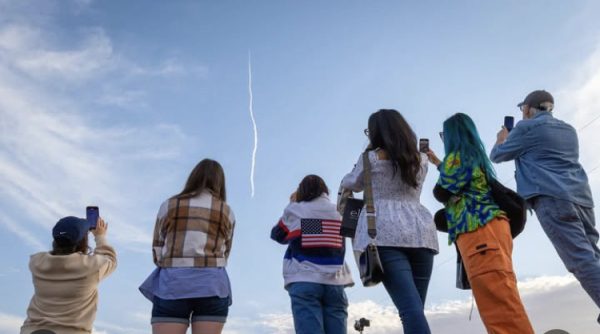






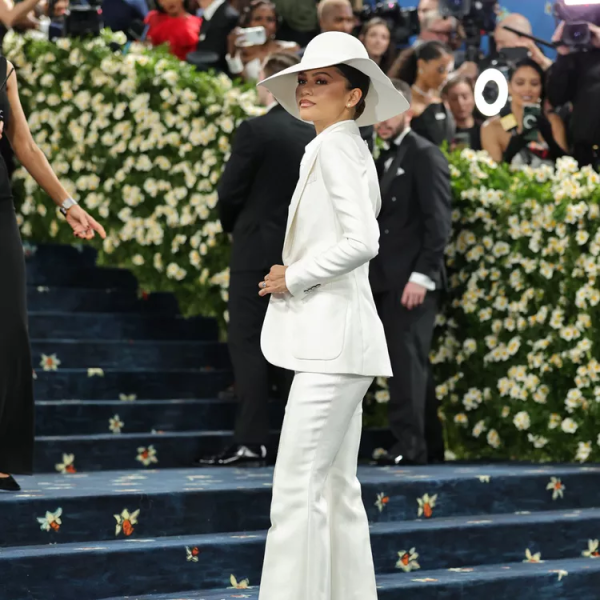


Bob Jones • Jan 29, 2019 at 10:16 pm
What about Schrodinger’s Cat?